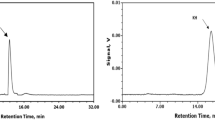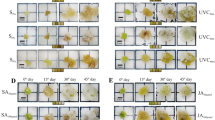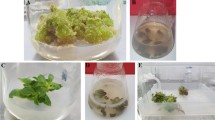Abstract
Callus and cell suspension cultures of Silybum marianum (L.) Gaertn. (Asteraceae) were established from in vitro germinated sterile plantlets. The cultures grew in Murashige and Skoog medium containing 1 mg l−1 2,4-dichlorophenoxyacetic acid (2,4-D) and 0.1 mg l−1 kinetin. A reversed phase-high performance liquid chromatography method for determination of flavanolignans in plant material was developed using an isocratic solvent system comprising acetonitrile and water containing 0.5% (v/v) phosphoric acid. Silychristin was the major flavanolignan produced by the cultured cells followed by silydianin. Elicitation of cultured S. marianum cells with 100 μg ml−1 yeast extract increased silychristin production from 0.11 to 0.23 mg g−1 fresh weight. Free radical scavenging activity was tested for the cultured cells using 1,1-diphenyl picryl hydrazyl (DPPH) radical. Extract prepared from the cultured cells of S. marianum showed 48% inhibition compared to 55% inhibition of the extract prepared from the fruits. Cytotoxic activity was tested using liver carcinoma cell line (HEPG2). Cultured cells and fruit extracts showed a significant cytotoxic activity of IC50 = 1.01 and 0.47 μg, respectively. Extract of S. marianum cultured cells ameliorated the adverse effects of carbon tetrachloride-induced hepatic injury in rats and returned the altered levels of biochemical markers to near normal levels.



Similar content being viewed by others
References
Becker H, Schrall R (1977) Tissue and suspension cultures of Silybum marianum: the formation of flavanolignans by flavanoids and coniferyl alcohol. Planta Med 32(1):27–32
Boulos L (2000) Flora of Egypt. Al Hadara, Cairo
Cacho M, Moran M, Corchete P, Fernandez-Tarrago J (1999) Influence of medium composition on the accumulation of flavanolignans in cultured cells of Silybum marianum (L.) Gaertn. Plant Sci 144:63–68
Deep G, Oberlies NH, Kroll DJ, Agarwal R (2008) Identifying the differential effects of silymarin constituents on cell growth and cell cycle regulatory molecules in human prostate cancer cells. Int J Cancer 123:41–50
Flora K, Hahn M, Rosen H, Benner K (1998) Milk thistle (Silybum marianum) for the therapy of liver disease. Am J Gastroenterol 93:139–143
Fraschini F, Demartini G, Esposti D (2002) Pharmacology of silymarin. Clin Drug Invest 22(1):51–65
Hasanloo T, Kavari-Nejad RA, Majidi E, Shams Ardakani MR (2008) Flavonolignan production in cell suspension culture of Silybum marianum. Pharm Biol 46(12):876–882
Klassen CD, Plaa GL (1969) Comparison of the biochemical alteration elicited in liver of rats treated with carbon tetra chloride and chloroform. Biochem Pharmacol 18(8):2019–2027
Lee SK, Mbwambo ZHY, Chung H, Luyengi L, Gamez EJC, Mehta RG, Kinghorn AD, Pezzuto JM (1998) Evaluation of the antioxidant potential of natural products. Comb Chem High Throughput Screen 1:35–46
Morazzoni P, Bombardelli E (1995) Silybum marianum (Cardus marianum). Fitoterpia 66:3–42
Murashige T, Skoog F (1962) A revised medium for rapid growth and bioassays with tobacco tissue culture. Physiol Plant 15:473–497
Namdeo AG (2007) Plant cell elicitation for production of secondary metabolites: a review. Pharmacog Rev 1:69–79
Sánchez-Sampedro MA, Fernández-Tárrago J, Corchete P (2005a) Yeast extract and methyl jasmonate-induced silymarin production in cell cultures of Silybum marianum (L.) Gaertn. J Biotechnol 119:60–69
Sánchez-Sampedro MA, Fernández-Tárrago J, Corchete P (2005b) Enhanced silymarin accumulation is related to calcium deprivation in cell suspension cultures of Silybum marianum (L.) Gaertn. J Plant Physiol 162(10):1177–1182
Shah J, Klessig DF (1999) Salicylic acid: signal perception and transduction. In: Libbenga K, Hall M, Hooykaas PJJ (eds) Biochemistry and molecular biology of plant hormones. Elsevier, Oxford, pp 513–541
Skehan P, Storeng R (1990) New colorimetric cytotoxicity assay for anti cancer drug screening. J Natl Cancer Inst 82:1107–1112
Tůmová L, Řimáková J, Tůma J, Dušek J (2006) Silybum marianum in vitro-flavonolignan production. Plant Soil Environ 52(10):454–458
Zhao B, Wolf DM, Agrawal R (1999) Inhibition of human carcinoma cell growth and DNA synthesis by silybinin, an active constituent of milk thistle: comparison with silymarin. Cancer Lett 147:77–84
Conflict of interest
The authors declare that they have no conflict of interest.
Author information
Authors and Affiliations
Corresponding author
Additional information
Communicated by S. Werbrouck.
Rights and permissions
About this article
Cite this article
Elwekeel, A., AbouZid, S., Sokkar, N. et al. Studies on flavanolignans from cultured cells of Silybum marianum . Acta Physiol Plant 34, 1445–1449 (2012). https://doi.org/10.1007/s11738-012-0942-x
Received:
Revised:
Accepted:
Published:
Issue Date:
DOI: https://doi.org/10.1007/s11738-012-0942-x




